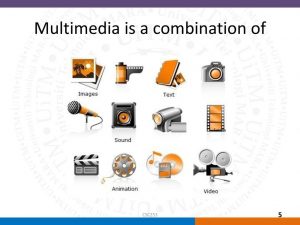Introduction to Multimedia
Definition: Multimedia refers to the integration of multiple forms of media such as text, audio, images, video, and animation into a single digital platform.
Components of Multimedia:
Text: The most basic form of media, used for written content.
Audio: Includes sound effects, music, speech, and other sound recordings.
Images: Static visual representations like photographs, diagrams, and illustrations.
Video: Moving visual media that combines pictures and audio.
Animation: The process of creating motion and shape-change illusions.
- Multimedia Systems
Multimedia Hardware: Includes devices such as computers, smartphones, cameras, microphones, and speakers.
Multimedia Software: Applications and tools used to create, edit, and manage multimedia content (e.g., Adobe Photoshop, Final Cut Pro, Audacity).
Applications of Multimedia Systems:
Entertainment: Video games, movies, music.
Education: E-learning platforms, interactive tutorials.
Business: Marketing presentations, virtual meetings, training modules.
Healthcare: Telemedicine, medical imaging.
News and Information: Digital journalism, online news portals.
Advantages of Multimedia
- It makes teaching and learning easier in the classroom
- It makes the sharing of views, ideas, and thoughts among various people around the world easy.
- It can store the data and information for a long time.
- It is very cheap to get knowledge about the related subject matter in a short time through multimedia.
- It is very easy to use, handle, carry, copy, and store data.
- It allows adding audio, video, text, and graphics to make the subject matter interactive and attractive.
- It has wide use in interactive web pages, video conferencing, distance education, and seminars.
- Multimedia Data Representation
Formats:
Text: TXT, DOC, PDF.
Audio: MP3, WAV, AAC.
Images: JPEG, PNG, GIF.
Video: MP4, AVI, MKV.
Animation: SWF, GIF.
Compression:
Lossy Compression: Reduces file size by removing some data (e.g., JPEG, MP3).
Lossless Compression: Reduces file size without losing any data (e.g., PNG, FLAC).
- Multimedia Authoring Tools
Types:
Graphic Design Tools: Adobe Photoshop, CorelDRAW.
Audio Editing Tools: Audacity, Adobe Audition.
Video Editing Tools: Adobe Premiere Pro, Final Cut Pro.
Animation Tools: Adobe Animate, Blender.
Web Design Tools: Adobe Dreamweaver, WordPress.
Features:
– User-friendly interfaces.
– Integration with other multimedia tools.
– Support for various file formats.
– Advanced editing and creation capabilities.
- Multimedia and the Internet
Web Technologies:
– HTML5: Provides support for embedding multimedia elements directly into web pages.
– CSS: Used for styling multimedia content.
– JavaScript: Enables interactive multimedia elements on web pages.
– Streaming Technologies: Live and on-demand audio and video streaming (e.g., YouTube, Netflix).
Content Delivery:
– Web Hosting: Storing and delivering multimedia content online.
– Content Delivery Networks (CDNs): Distribute content to users efficiently by caching it in multiple locations.
- Multimedia Development Process
Stages:
- Planning: Define goals, audience, and requirements.
- Design: Create storyboards, layouts, and scripts.
- Development: Produce multimedia elements and integrate them.
- Testing: Ensure functionality, compatibility, and usability.
- Deployment: Publish the final product.
- Maintenance: Update and maintain the content as needed.
Considerations:
– Usability: Ensure ease of use and navigation.
– Accessibility: Make content accessible to all users, including those with disabilities.
– Performance: Optimize loading times and responsiveness.
– Interactivity: Engage users with interactive elements.
- Future Trends in Multimedia
Emerging Technologies:
– Virtual Reality (VR): Immersive environments.
– Augmented Reality (AR): Overlaying digital content in the real world.
– Artificial Intelligence (AI): Enhancing multimedia creation and personalization.
– 5G Networks: Faster and more reliable mobile internet for streaming and real-time interactions.
Impacts:
– Enhanced User Experiences: More immersive and engaging multimedia content.
– New Applications: Expanded use in various fields such as education, healthcare, and entertainment.
– Technological Advancements: Continuous evolution of hardware and software capabilities.







